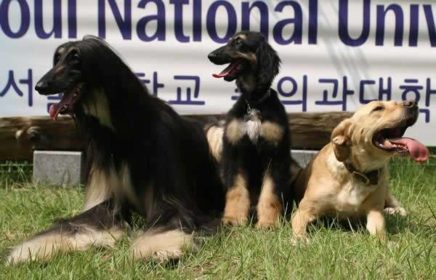
It’s generally known that the first cloned canine was “Snuppy,” a dog cloned from a cell taken from the ear of a three year old Afghan Hound. Almost nothing was ever said about the role that purebred dogs played in the breakthrough. Cloning research relies heavily on female dogs, not just for their eggs, but to be surrogates to birth the clones – and many of them are purebred dogs.
Why purebred dogs? Or for that matter, why was an Afghan Hound chosen to be cloned? Gerald Schatten from the University of Pittsburgh School of Medicine said, “Having a distinctive dog means that if we’d [ended up with] a Dachshund we’d know that something funny had happened.”
The cloning team used somatic cell nuclear transfer, the same technique used to create Dolly, the sheep. To clone Snuppy, the researchers implanted nuclei from his father’s ear cells into eggs from female dogs, having removed the eggs’ nuclei. After being zapped with a small electric shock to start development, the embryos were implanted into the uterus of a surrogate mother – in Snuppy’s case, a Labrador Retriever. The team used DNA fingerprinting to confirm that Snuppy was genetically identical to his “father”.
Dogs proved to be more difficult to clone than a sheep like “Dolly,” the first cloned animal. A dog’s breeding period was more limited than other species’, and her eggs couldn’t be easily extracted from the ovaries as they can with pigs and cows. Of the 1,095 extracted eggs that the clone team implanted in 123 surrogates, two made it to term, and one died a few weeks after birth. Snuppy was the lone cloned survivor. In 2008, Snuppy reportedly sired his own puppies.
In 2015, Snuppy celebrated his 10th birthday, but he died of cancer just 13 days later. For some, it answered the question as to whether a cloned animal’s aging is accelerated because of cloning.
Snuppy and his somatic cell donor, Tai, another Afghan Hound, were in good health until both developed cancer which killed them at the ages of 10 and 12 years, respectively. Some said that since the longevity of both the donor and the cloned dog was close to the median lifespan of Afghan Hounds, around 11.9 years of age, the answer would be no, cloning does not accelerate aging, at least not in this case. In an abstract written by the members of the original cloning team, it was reported that in 2017, three healthy reclones of Snuppy were alive, and as with Snuppy, they didn’t anticipate that the reclones would go through an accelerated rate of aging, or be more prone to develop diseases than naturally bred animals.
All this reminds us of something our elders used to say: Just because you can do something doesn’t mean you should. Conversely, data from Tai and Snuppy may provide insights into the development of cancer. We are of the opinion that cloning will never duplicate a beloved dog because it would be impossible to replicate every experience the original dog had, experiences that shape a dog’s personality. Philosopher Mark Greene said, “Cloning does not buy immortality; it is not cheating death. Cloning is no more a way to extend the life of an individual animal than having a genetically identical twin is a way for one individual to live two lives simultaneously — twins are distinct individuals, and so are clones.”
What say you? If you could, would you clone your dog?
A parting bit of trivia: The origin of the first clone’s name, “Snuppy” came from an amalgam of “Seoul National University puppy.”
Image of Snuppy next to the male Afghan hound from which he was cloned, and his surrogate mother, a yellow Labrador Retriever. Image from Pinterest and happily credited upon receipt of information.
If you are interested in helping researchers find improved treatment and maybe even a cure for breast cancer which impacts  humans and canines alike, part of your purchase of the insulated tote bag at the right will be donated to the National Canine Cancer Foundation, the proceeds to be earmarked for canine mammary cancer research. Get your bag here by going to the bottom of the page.
humans and canines alike, part of your purchase of the insulated tote bag at the right will be donated to the National Canine Cancer Foundation, the proceeds to be earmarked for canine mammary cancer research. Get your bag here by going to the bottom of the page.
